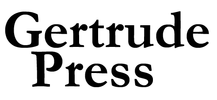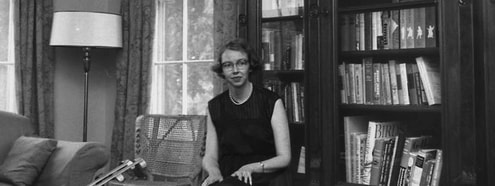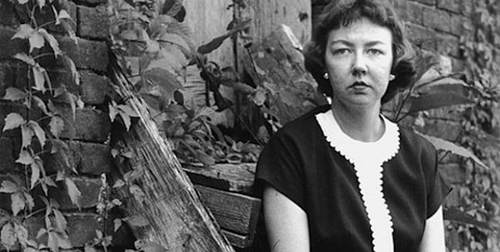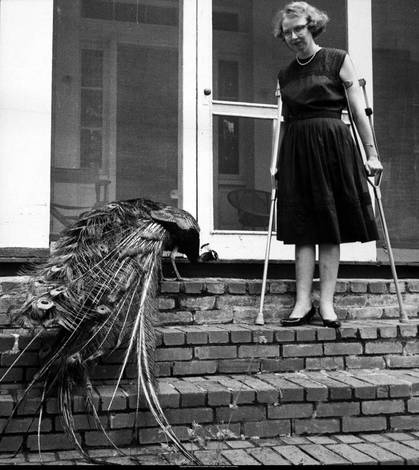|
LINEAGE:
Rita Mae Reese on
Flannery O'Connor |
Perhaps there had been other things ... that Regina burned before anyone could come and turn her daughter into something other than what she wanted her to be. |
Loving HulgaWhen I was 19, I got a job mowing grass at Naiad Press, the oldest and largest lesbian publisher in the world at the time. It was located in a small house in a residential wooded area in north Florida. One day in the kitchen, the topic of Flannery O’Connor came up. Barbara, who had literally written the book on lesbians in literature at the time, her attention focused like a shark who smells blood, asked, “Was Flannery a lesbian?”
I’ve spent years trying to answer this question for myself. I first read Flannery O'Connor in a lit survey course in my first or second year of college in West Virginia. I knew she was supposed to be "Southern" but she felt very Appalachian to me, very hillbilly in this totally unabashed way. I knew “hillbillies” were the butt of jokes or the object of pity, when we got any attention at all, and so I was amazed to read this pitiless work that turned the tables, made the joke be on the people who felt so superior, who were so sure they were the good people. In a later literary theory class, I did a presentation on Barbara Smith. My presentation was essentially writing the word “lesbian” on the chalkboard and then erasing it. I did this several times and then said that this was, essentially, the history of lesbian writing.
Now that I think on it, it is also a history of my influences. I erase them or neglect them, but the chalk traces remain. It might also be history of O’Connor’s sexuality. I became aware that the O’Connor I had come to know was filtered by other people, most notably by her mother and by Sally Fitzgerald, who edited O'Connor’s essays and letters. Her mother was anxious to prove that O'Connor wasn’t white trash. Sally Fitzgerald (uber-Catholic mother of the guy who directed The Passion) was eager to prove that O’Connor was a “good” Catholic and a “normal” heterosexual woman. The writer Caroline Gordon, who was an important mentor for O’Connor, once wrote to her: “(H)omosexuality, childishness, freakishness—in end, I think it comes down to fatherlessness—is rampant in the world today. And you are giving us a terrifying picture of the modern world, so your book is full of freaks.” To me, Gordon is a jerk—for instance, she believed women shouldn’t vote (and this was in the 1950s, not the 1850s). Her comment on fatherlessness seemed a remarkably insensitive one to O’Connor, who lost her father to lupus when she was only fifteen and was devastated by that loss. O’Connor was forced into the role of the perpetual child by her illness, being forced to live with her mother for nearly her entire adult life. I read Gordon’s reference to homosexuality as a veiled threat to O’Connor, to not let this final element of “freakishness” show too plainly. There is very little sex or overt sexual desire in O’Connor’s published work of any kind, and the only homosexual sex referred to is a rape. Still, I assumed O’Connor was a lesbian. It could have been a bias, my thinking that a writer this good had to be a lesbian. (But then again I’ve never suspected that Toni Morrison is a lesbian.) O’Connor often wrote male main characters, but this was common practice for lesbian writers up until fairly recently, to write honestly without fear of exposure. I made frequent pilgrimages to her home (once jumping the fence with a future National Book Award winner, before the house was open to the public) and began working on a book of poems about her. During one of these pilgrimages, I picked up a copy of HABIT OF BEING, her collected letters. The letters are funny and revealing, and a large number are to lesbian correspondents. I was stunned that O’Connor, a Catholic woman living in rural Georgia in the 1950s, seemed to have more close lesbian friends than I had, including her two closest friends, Maryat Lee and Betty Hester. Maryat was a tall, charismatic and “out” woman who declared her love to O'Connor (who demurred). Betty Hester (who had only been identified as “A” in HABIT OF BEING) was a prolific reader who had been kicked out of the army for being a lesbian and lived in Atlanta. She had written a fan letter to O’Connor and they began a bit of a flirtation, swapping reading recommendations (particularly around Simone Weil) and describing their physical selves to each other in letters (hard now to even imagine the days before the Internet when you had time to imagine someone’s appearance before actually seeing it). O’Connor wrote that she imagined Hester “with thick horn-rimmed spectacles, a Roman nose, and ash-blonde hair” and in the next letter was “only too glad to swap all my images of you for the ginger beer bottle with the head of Socrates.” O’Connor described herself as “being dammed by a faint prettiness turned a mite sour.” Later, after O’Connor had induced Betty to visit her at Andalusia, the dairy farm in Milledgeville where she lived with her mother, she wrote: “I had the impression that all the time you were here you were poised for flight—a lark with a jet engine—and that if I had turned my back you would have been gone.” She said she would use her commanding voice with Betty the next time, though she lamented that in person, she was not commanding at all. She urged Betty to visit again and stay longer, to eat a meal with them. She went on to point out that Betty had misled her about her appearance, and that in truth she wasn’t “even passably ugly.” Eventually, she got Betty to come and spend the night, and after the visit, wrote to Betty that it was up to her to explain to the hired woman why her bed hadn’t been slept in.
|
These are the things that appear in the letters that were heavily edited by Regina and Sally Fitzgerald. Regina had been in the process of burning O'Connor’s papers when Sally managed to stop her so that the work could be collected and curated. It is impossible to say what went into the flames before that happened or what surviving was simply edited out of the record.
There is an apocryphal story about the filming of The Displaced Person, a movie version of O’Connor’s story by that name. It was filmed at Andalusia, and the lawyer cases (of which she’d been very proud) in O’Connor’s bedroom were moved for one of the shots. Three paperbacks fell out—all lesbian pulp novels. The story may or may not be true; if true, O’Connor might have procured the books to simply better understand the lives of her closest friends. But she would have gone to a lot of trouble to get them and then to hide them in order to keep them. Perhaps there had been other things like that, less well hid, that Regina burned before anyone could come and turn her daughter into something other than what she wanted her to be. I knew 'hillbillies' were the butt of jokes or the object of pity, when we got any attention at all, and so I was amazed to read this pitiless work that turned the tables, made the joke be on the people who felt so superior, who were so sure they were the good people. At the end of O’Connor’s life, she was at work on a novel she was calling WHY DO THE HEATHENS RAGE? It was a ramshackle affair, with multiple drafts petering out, name changes mid-stream, centering largely around a character named Walter who lived with his mother and wrote letters all day instead of working on the novel he was supposed to be writing. Walter becomes infatuated with a woman who embodies the liberal ideals of Maryat Lee—very race conscious and involved with the plight of the poor. Walter writes many letters begging her to visit and then is in a panic when she is set to arrive. She’ll see he is not what he is supposed to be. Walter’s imagining of what will happen upon Oona’s arrival, includes the most erotic writing I’ve ever seen from O’Connor: “parting a pink gold shower of hair, dividing it upon a back bare its length” and “bending to kiss exactly the hollow of her back, exactly the spot best suited to receive first his lips and then his cheek.” I incorporated this language into “At 36, Hulga Speaks of Love,” a poem about Flannery/Hulga longing for a relationship that might never have been consummated.
A few years and many failed poems into the Flannery project, I realized that I had no idea what I was doing. I felt like I was invading a dead woman’s privacy and that my version of Flannery O’Connor wasn’t exactly the point I was trying to make (if I was trying to make any point at all). I also realized it was not the overall Flannery O’Connor that I wanted to write about, but the self as she saw herself and who she was with Betty Hester (the version that put her “in the devil’s hands”). I went back to my notes and uncovered a line in one of her letters to Betty. O’Connor had commented to Betty that she reminded her of Simone Weil, the French philosopher who “did kill and slay herself by refusing to eat whilst the balance of her mind was disturbed” (in the words of the Coroner's Court report). O’Connor said that if she lived long enough she’d like to write a novel about an “angular intellectual proud woman approaching God inch by inch with ground teeth” and when Betty assumed she meant Weil, O’Connor corrected her and said she already had the character—Hulga. Hulga was her character in “Good Country People,” the story about a middle-aged woman with a Ph.D. in Philosophy and a wooden leg (the maimed body and the oversized intellect in a woman being a veritable Venn’s diagram of “freakishness” for a lot of readers) who decides to seduce a traveling bible salesman not out of physical desire but to prove the superiority of her nihilism over his Christianity. Hulga was O’Connor’s most autobiographical character, and my personal favorite. (How could you not love her after this passage? “Sometimes she went for walks but she didn’t like dogs or cats or birds or flowers or nature or nice young men. She looked at nice young men as if she could smell their stupidity.”) Much has been made of O’Connor’s relationship with a young textbook salesman, which this story seems to use as its basis. She shared a kiss with this salesman, which he later said was like kissing a corpse because she grinned through the whole thing. This has been offered as proof that O’Connor was in love with him and that she was completely incompetent in sexual matters. It could, of course, be read differently. In THE BOOK OF HULGA, I wanted to give Hulga a taste of the freedom that Flannery O’Connor seems to have never fully enjoyed. I’ve imagined a possible life for her, beyond the hayloft and the bible salesman. I wanted to honor in general the relationship between a writer and a character, and between a writer and a reader. More importantly, I wanted to honor O’Connor’s deep relationship with Betty Hester, a fascinating woman in her own right, and with Simone Weil, the woman they used as a bridge to draw them closer together. Was Flannery O'Connor a lesbian? I still can’t answer that question, but my Hulga is. Maybe the answer doesn’t really matter as much as where the question has taken me. We find our influences, but in a very real way, we create them too. 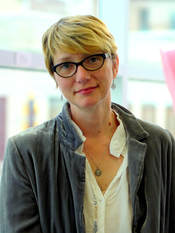
Rita Mae Reese is the author of THE ALPHABET CONSPIRACY and THE BOOK OF HULGA, which was selected by Denise Duhamel for the Felix Pollak Prize. She is a recipient of a Rona Jaffe Foundation Writers’ Award, a Stegner fellowship in fiction, a “Discovery”/The Nation award, and a Pamaunok Poetry Prize, among other awards. She designs lesbian poet trading cards for Headmistress Press and is the Director of Literary Arts at the Arts + Literature Laboratory in Madison, Wisconsin.
Find out more at ritamaereese.com. |
Work by Flannery O'ConnorNovels
Wise Blood (1952) The Violent Bear It Away (1960) Short story collections A Good Man Is Hard to Find and Other Stories (1955) Everything That Rises Must Converge (1965) The Complete Stories (1971), which won the National Book Award Other Work Mystery and Manners: Occasional Prose (1969) The Habit of Being: Letters of Flannery O'Connor (1979) The Presence of Grace: and Other Book Reviews (1983) Flannery O'Connor: Collected Works (1988) Flannery O'Connor: The Cartoons (2012) A Prayer Journal (2013) |
